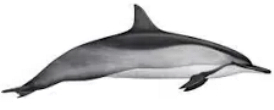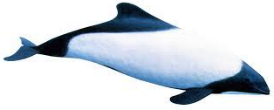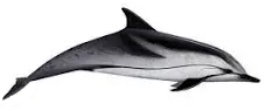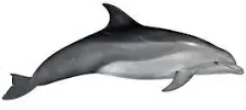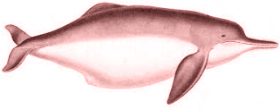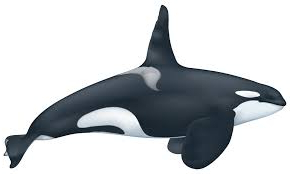 A dolphin is a cetacean, an aquatic mammal with a streamlined body and two limbs that are modified into flippers. Dolphins range in size from the 1.6 metre long Spinner dolphin to the 9 metre Orca. Though not as flexible as seals, they are faster; some dolphins can briefly travel at speeds of 29 kilometres per hour and leap 9 metres. Dolphins use their conical teeth to capture fast-moving prey. They have well-developed hearing which is adapted for both air and water. Some species are adapted for diving to great depths. Dolphins have a layer of fat, or blubber, under the skin to keep warm in cold water. A bulbous protuberance on the head, called a melon, holds the organ responsible for echolocation. The name 'dolphin' is often used as a synonym for bottlenose dolphin, the most common and familiar species of dolphin. There are also six species of dolphins commonly thought of as whales, the most well-known of which are the Pilot whale and the Orca, or 'Killer whale'. Although the terms dolphin and porpoise are sometimes used interchangeably, porpoises belong to a different family; they have a shorter beak and spade-shaped teeth, and differ in their behaviour. Here are some of the most well-known types of dolphins:
A group of dolphins is called a school or a pod. Just as with whales, male dolphins are called bulls, females are called cows and young dolphins are called calves. Breathing involves expelling stale air from their blowhole, in an upward blast, which may be visible in cold air, followed by inhaling fresh air into the lungs. Dolphins have rather small spouts. Dolphins feed largely on fish and squid, but a few, such as the orca, feed on large mammals such as seals. Male dolphins typically mate with multiple females every year, but females only mate every two to three years. Calves are typically born in the spring and summer months and females bear all the responsibility for raising them. Dolphins communicate using a variety of clicks, whistle-like sounds and other vocalizations, using nasal airsacs located just below the blowhole. The whistle-like sounds are produced by vibrating connective tissue, similar to the way human vocal cords function. The clicks are directional and are for echolocation. Dolphin echolocation clicks are amongst the loudest sounds made by marine animals. Bottlenose dolphins have been found to have signature whistles, a whistle that is unique to a specific individual. These whistles are used in order for dolphins to communicate with one another by identifying an individual. It can be seen as the dolphin equivalent of a name for humans.  Dolphins are known to teach, learn, cooperate, scheme, and grieve.
The brains of many species of dolphins contain neurons that, prior to 2007, were known only in hominids. In humans, these cells are involved in social conduct, emotions, and judgment. Cetacean neurons are found in areas of their brains that are analogous to where they are found in humans, suggesting that they perform a similar function.
Orcas have the second largest brain mass of any animal on earth, next to the sperm whale. The brain-to-body mass ratio in some is second only to humans.
Dolphins are known to teach, learn, cooperate, scheme, and grieve.
The brains of many species of dolphins contain neurons that, prior to 2007, were known only in hominids. In humans, these cells are involved in social conduct, emotions, and judgment. Cetacean neurons are found in areas of their brains that are analogous to where they are found in humans, suggesting that they perform a similar function.
Orcas have the second largest brain mass of any animal on earth, next to the sperm whale. The brain-to-body mass ratio in some is second only to humans.
Self-awareness is seen to be a sign of highly developed, abstract thinking. Self-awareness is believed to be the precursor to more advanced processes like meta-cognitive reasoning ('thinking about thinking') that are typical of humans. Research in this field has suggested that cetaceans, among others, possess self-awareness. Dolphins are highly social, often living in pods of up to a dozen individuals. In places with lots of food, pods can merge temporarily; such groupings may exceed 1,000 dolphins. Dolphins establish strong social bonds, and will stay with injured or ill members, helping them to breathe by bringing them to the surface if needed. This altruism does not appear to be limited to their own species; they have been seen protecting swimmers from sharks by swimming circles around the swimmers, or charging the sharks to make them go away. Dolphins also display tool use. Indo-Pacific bottlenose dolphins have been observed teaching their young to use sponges; they cover their snouts with sponges to protect them while foraging. Another learned behavior was discovered among river dolphins in Brazil, where some male dolphins use weeds and sticks as part of a sexual display.  Dolphins show various types of playful behaviour, often including objects, self-made bubble rings, other dolphins or other animals. Playful behaviour that involves another animal species with active participation of the other animal has also been observed. Playful dolphin interactions with humans are the most obvious examples, followed by those with humpback whales and dogs.
Dolphins show various types of playful behaviour, often including objects, self-made bubble rings, other dolphins or other animals. Playful behaviour that involves another animal species with active participation of the other animal has also been observed. Playful dolphin interactions with humans are the most obvious examples, followed by those with humpback whales and dogs. Juvenile dolphins off the coast of Western Australia have been observed chasing, capturing, and chewing on blowfish. While some reports state that the dolphins are becoming intoxicated on the tetrodotoxin in the fishes' skin, other reports have characterized this behavior as normal curiosity. |
